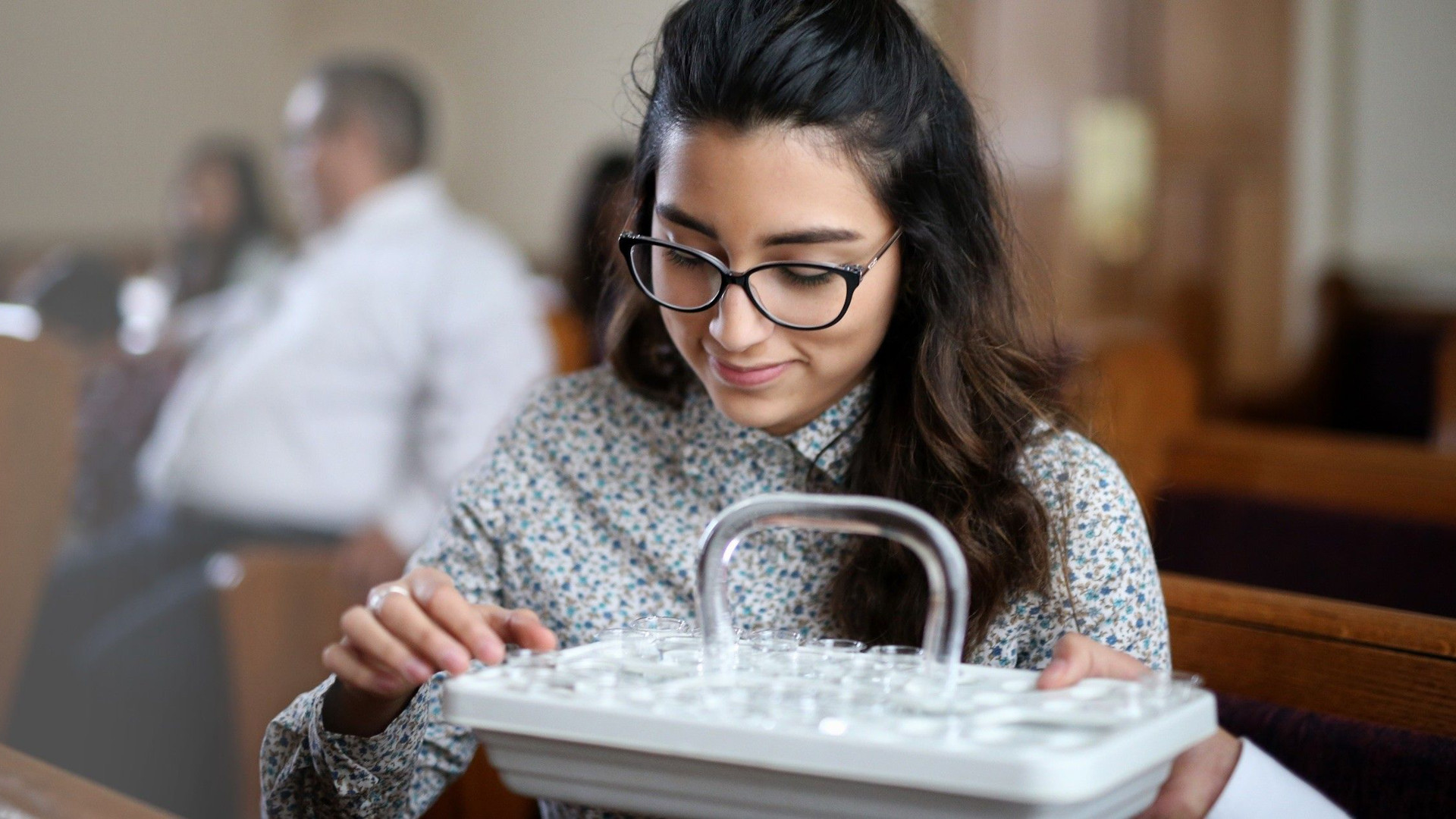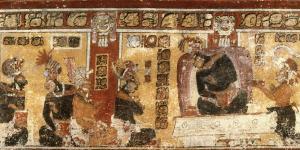You are here
Why Are We Invited to Partake of the Sacrament with Our Right Hand?

1 Corinthians 11:26
The Know
Latter-day Saints partake of the sacrament once a week, reflecting an ancient Christian practice meant to “shew the Lord’s death till he come” (1 Corinthians 11:26). Furthermore, members of Christ’s restored Church have been counseled to “partake [of the sacrament] with their right hand when possible.”1
Though this ritual action may seem trivial, it has meaningful ancient roots that, unfortunately, are mostly lost on most modern audiences. Brent J. Schmidt has pointed out that the right hand was often used in ancient contexts when making covenants, noting how some cultures would dedicate the right hand to different deities when it was raised.2 Similarly, Hugh Nibley frequently referred in his writings to these ancient covenant gestures, which often involved the raising the right hand in the air as well as extending it in ritual handclasps.3
This symbolism is found throughout the Bible. For example, when making a covenant “to not take anything unjustly” from the king of Sodom,4 Abram raised his right hand and said, “I have lift up mine hand unto the Lord, the most high God, the possessor of heaven and earth” (Genesis 14:22). Through this covenantal action, both Abram and the king were able to come to an agreement and create “an atmosphere of peace.”5
Reciprocally, the right hand of the Lord also shows up repeatedly in psalms regarding deliverance and salvation. In Psalm 17:7 the Lord is praised as the one “that savest by thy right hand them which put their trust in thee.” Psalm 118:16 declares, “The right hand of the Lord is exalted: the right hand of the Lord doeth valiantly.” Because of this, promises of life and salvation are offered to those who praise and serve the Lord (see Psalm 118:17–21). Still other psalms described the petitioner grasping the Lord’s right hand in order for them to be brought into His presence and become like Him.6
The New Testament mentions the right hand in similar covenantal contexts relating to salvation. Jesus Himself declared that He would sit “on the right hand of power” following His Crucifixion and Resurrection (Matthew 26:64). Witnessing the fulfillment of this prophecy before his martyrdom, Stephen saw “Jesus standing on the right hand of God, and said, Behold, I see the heavens opened, and the Son of man standing on the right hand of God” (Acts 7:55–56).
Not only is Jesus repeatedly described as sitting on the right hand of God but this blessing is also offered to all who follow Him: “Then shall the King say unto them on his right hand, Come, ye blessed of my Father, inherit the kingdom prepared for you from the foundation of the world” (Matthew 25:34). In the end, Schmidt observes that “there are 166 uses of the right hand in the Bible to demonstrate fidelity, strength, and power.” These instances “parallel the covenant significance of the right hand and right handclasps granting blessings” in other cultures.7
The symbolism behind the right hand in covenantal contexts became so rooted in the Greco-Roman world that in Latin, the word for right held favorable connotations, whereas the word for left evoked that which is wrong, perverse, unfavorable, or sinister.8 These negative connotations of the left hand are still seen in some modern languages, including English and French. Other cultures, such as the ancient Maya, similarly viewed the left hand in a negative light in ritual contexts, as they connected it with foolishness.9 Thus, the appropriateness of using the right hand, especially in covenantal or contractual contexts, has a long pedigree in many cultures throughout the world.
The Why
The sacrament is a sacred ordinance instituted by the Lord Jesus Christ. It is filled with symbolic meaning meant to draw our minds to the Lord’s atoning sacrifice and the covenants that we have voluntarily made to follow Him. The use of the right hand evokes and invokes the covenantal significance of this sacred ordinance.
Specifically, we covenant that we “are willing to take upon [us] the name of thy Son, and always remember him and keep his commandments which he has given [us].” We are then promised that as we fulfill this covenant, we will have the Holy Ghost with us.10 At His Last Supper, Jesus invited His Apostles to “take, eat” (Matthew 26:26; Mark 14:22). By taking and partaking of the bread and water with our right hands, we symbolically accept the Lord’s personal invitation for us to voluntarily enter into or renew our covenant of loyalty and faithful obedience to our Heavenly Father through the goodness of Jesus Christ.
Due to the prominent use of the right hand in making sacred, life-giving oaths throughout history, President Russell M. Nelson once remarked that the “hand used in partaking of the sacrament would logically be the same hand used in making any other sacred oath. For most of us, that would be the right hand.”11 President Nelson continued, “The sacrament was instituted by [Jesus Christ]. For all mankind, even me, he offered his flesh and blood and designated the bread and the water as symbolic emblems. Because I have a right hand, I offer it in partaking of the sacrament as an oath, that I will always remember his atoning sacrifice, take his name upon me and remember him, and keep the commandments of God.”12
It is important to recognize that while we are encouraged to partake of the sacrament with our right hand, this may not always be possible, and any such inability or failure to do so—whether due to a physical disability, lack of awareness about the symbolism, or some other similar reason—does not invalidate the ordinance.13 Consequently, no one should worry if they or someone else cannot use the right hand in this ordinance or if, for whatever reason, they have not done so in the past. According to President Nelson, all covenants, including sacramental and temple covenants, “can be and are made by those who have lost the use of the right hand, or who have no hands at all. Much more important than concern over which hand is used in partaking of the sacrament is that the sacrament be partaken with a deep realization of the atoning sacrifice that the sacrament represents.”14 Thus, rather than becoming a burden or a reason for worry or concern, the symbolism of the right hand, where it can be implemented or observed, can amplify the significance and binding meaning of the ordinance in the minds and hearts of all.
Further Reading
Brent J. Schmidt, Relational Faith: The Transformation and Restoration of Pistis as Knowledge, Trust, Confidence, and Covenantal Faithfulness (Provo, UT: BYU Studies, 2022), 87–118.
Hugh Nibley, The Message of the Joseph Smith Papyri: An Egyptian Endowment (Provo, UT: FARMS; Salt Lake City, UT: Deseret Book, 2005), 427–457.
Hugh Nibley, “Apocryphal Writings and the Teachings of the Dead Sea Scrolls,” in Temple and Cosmos: Beyond this Ignorant Present (Provo, UT: FARMS; Salt Lake City, UT: Deseret Book, 1992), 264–335.
Russell M. Nelson, “Is It Necessary to Take the Sacrament with One’s Right Hand? Does It Really Make Any Difference Which Hand Is Used?,” Ensign, March 1983.
- 1. General Handbook: Serving in The Church of Jesus Christ of Latter-day Saints, 18.9.4.
- 2. Brent J. Schmidt, Relational Faith: The Transformation and Restoration of Pistis as Knowledge, Trust, Confidence, and Covenantal Faithfulness (Provo, UT: BYU Studies, 2022), 93–94.
- 3. See, for example, Hugh Nibley, “Apocryphal Writings and the Teachings of the Dead Sea Scrolls,” in Temple and Cosmos: Beyond this Ignorant Present (Provo, UT: FARMS; Salt Lake City: Deseret Book, 1992), 278, 296, 300–301, 304–305, 308–311, 315–317 (this lecture was originally given in 1967); Hugh Nibley, The Message of the Joseph Smith Papyri: An Egyptian Endowment, 2nd ed. (Provo, UT: FARMS; Salt Lake City, UT: Deseret Book, 2005), 427–436.
- 4. Schmidt, Relational Faith, 91.
- 5. Schmidt, Relational Faith, 91.
- 6. See Book of Mormon Central, “Why Does the Psalmist Speak about Grasping God’s Hand? (Psalm 73:23–24),” KnoWhy 642 (August 16, 2022).
- 7. Schmidt, Relational Faith, 106.
- 8. Conjugated, the word for “left” in Latin is sinister (masculine), sinistra (feminine), sinestrum (neuter). As can be seen, the English word sinister derives from this same word.
- 9. In Mopan Maya, the word for “fool” (ajb’es) is also used for “left hand” (ajb’es k’a’). SeeCharles Andrew Hofling, Mopan Maya-Spanish-English Dictionary (Salt Lake City, UT: University of Utah Press, 2011), 79.
- 10. See 3 Nephi 18:7, 11; Moroni 4:3; 5:2; Doctrine and Covenants 20:77, 79.
- 11. Russell M. Nelson, “Is It Necessary to Take the Sacrament with One’s Right Hand? Does It Really Make Any Difference Which Hand Is Used?,” Ensign, March 1983.
- 12. Nelson, “Is It Necessary to Take the Sacrament with One’s Right Hand?”
- 13. Instructions regarding the worthiness of Christians are emphasized rather than small administerial matters such as which hand to partake the sacrament with. See, for example, 1 Corinthians 11:26–29; 3 Nephi 18:29; Mormon 9:29; Doctrine and Covenants 46:4.
- 14. Nelson, “Is It Necessary to Take the Sacrament with One’s Right Hand?”
KnoWhy Citation
Related KnoWhys
Subscribe
Get the latest updates on Book of Mormon topics and research for free





